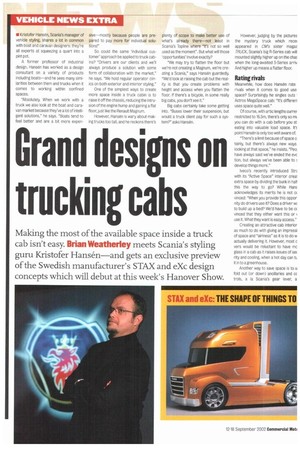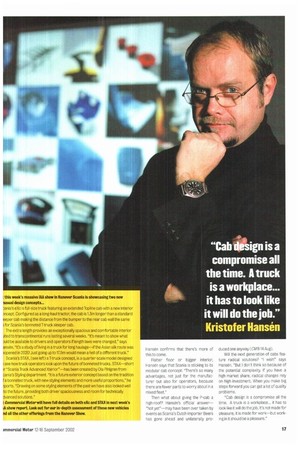Grand designs on trucking cabs
Page 16

Page 17

If you've noticed an error in this article please click here to report it so we can fix it.
Making the most of the available space inside a truck cab isn't easy. Brian Weatheriey meets Scania's styling gum Kristofer Hansen—and gets an exclusive preview of the Swedish manufacturer's STAX and eXc design concepts which will debut at this week's Hanover Show.
• Kristofer Hansen, Scania's manager of vehicle styling, shares a lot in common with boat and caravan designers: they're all experts at squeezing a quart into a pint pot.
A former professor of industrial design, Hansen has worked as a design consultant on a variety of products including boats—and he sees many similarities between them and trucks when it comes to working within confined spaces.
"Absolutely. When we work with a truck we also look at the boat and caravan market because they've a lot of intelligent solutions," he says. "Boats tend to feel better and are a bit more expen
sive—mostly because people are prepared to pay more for individual solutions!"
So could the same 'individual customer' approach be applied to truck cabins? "Drivers are our clients and we'll always produce a solution with some form of collaboration with the market," he says. "We hold regular operator clinics on both exterior and interior styling."
One of the simplest ways to create more space inside a truck cabin is to raise it off the chassis, reducing the intrusion of the engine hump and gaining a flat floor, just like the Renault Magnum.
However, Hansen is wary about making trucks too tall, and he reckons there's plenty of scope to make better use of what's already there—not least in Scania's Topline where "it's not so well used as the moment". But what will those 'opportunities' involve exactly?
"We may try to flatten the floor but we're not creating a Magnum, we're creating a Scania," says Hansen guardedly. "We'd look at raising the cab but the reality is that you create problems with height and access when you flatten the floor. If there's a bicycle, in some really big cabs, you don't see it."
Big cabs certainly take some getting into. "Buses lower their suspension, but would a truck client pay for such a system?" asks Hansen. However, judging by the pictures the mystery truck which recei appeared in CM'S sister magaz TRUCK, Scania's big R-Series cab will mounted slightly higher up on the chat when the long-awaited 5-Series arriv And higher up means a flatter floor.
Rating rivals
Meanwhile, how does Hansen rate rivals when it comes to good use space? Surprisingly he singles outs Actros MegaSpace cab: "It's differen1 uses space quite well."
Of course, with artic lengths currer restricted to 16.5m, there's only so mi you can do with a cab before you st eating into valuable load space. In point Hansen is only too well aware of.
"There's a limit because of space taint}, but there's always new ways looking at that space," he insists. "Peo have always said we've ended the evc tion, but always we've been able to develop things more."
lveco's recently introduced Stn with its "Active Space" interior creal extra space by dividing the bunk in halt this the way to go? While Hans acknowledges its merits he is not a vinced: "When you provide this oppor nity do drivers use it? Does a driver 14+4 to build up a bed? We'd have to be a vinced that they either want this or use it. What they want is easy access."
Creating an attractive cab interior as much to do with giving an impressi of space and "airiness" as it is to do w actually delivering it. However, most c vers would be reluctant to have mc glass in a cab as it raises issues of se( rity and cooling, when a hot day can tt, it in to a greenhouse.
Another way to save space is to u fold out (or down) ancillaries and cc trols, a la Scania's gear lever, a Hansdn confirms that there's more of this to come.
Flatter floor or bigger interior, Hansen says that Scania is sticking to its modular cab concept: "There's so many advantages, not just for the manufacturer but also for operators, because there are fewer parts to worry about in a mixed fleet."
Then what about giving the P-cab a nigh-roof? Hansen's official answer— 'Not yet"—may have been over taken by events as Scania's Dutch importer Beers has gone ahead and unilaterally pro duced one anyway (CM8-14 Aug).
Will the next generation of cabs feature radical soiutionsP 1 wish!" says Hansen. "But I don't think so because of the potential complexity. If you have a high market share, radical changes rely on high investment. When you make big steps forward you can get a lot of quality problems.
"Cab design is a compromise all the time. A truck is a workplace... it has to look like it will do the job. It's not made for pleasure, it is made for work—but working in it should be a pleasure."




























































































































































